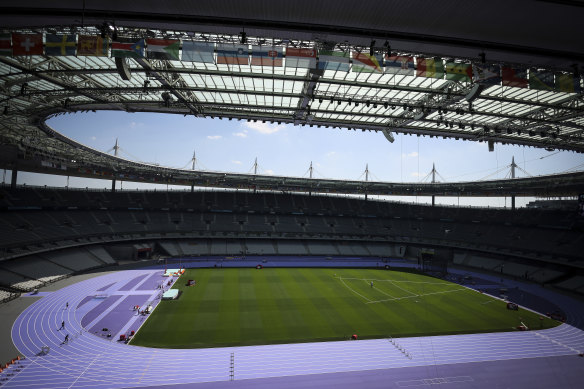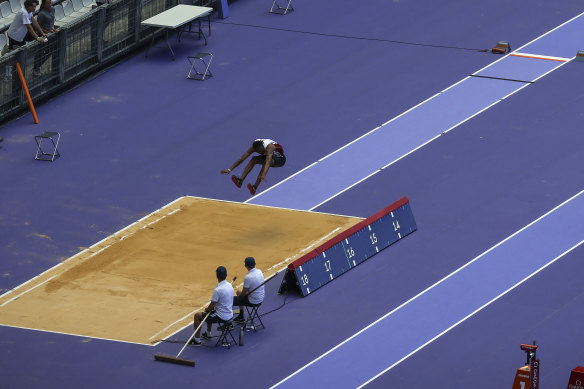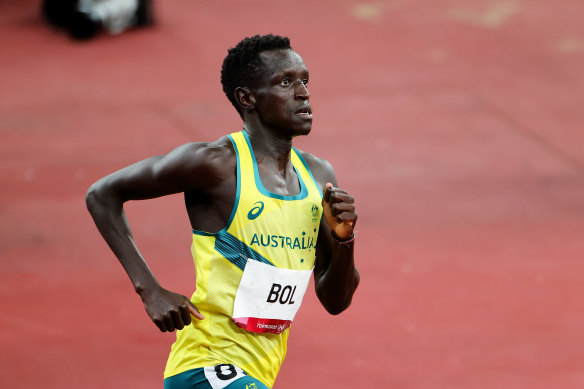‘It has to be pretty’: Why the Paris athletics track is purple
The athletics track in Paris is purple. Ask why the Parisians have chosen a purple track for the Olympics and it prompts the most Parisian of responses: a Gallic shrug.
There is no answer. It’s more of a why not than a why.

The athletics track at the Stade de France in Paris is purple.Credit: AP
The colour is the only thing really different about the track at the Stade de France, the venue for track and field at the Olympics and Paralympics. It is the same vulcanised rubber - two layers of the stuff - and is made by the same company that manufactured the tracks for previous Games.
In a country that defines style and class, that brought the world couture, the French have added their own touch to the track by making it purple.
Athletes at the Tokyo Olympics thought the track there - the synthetic Mondo WS-TY4 was very fast. And it was.
There were three world records and 12 Olympic records set on the Tokyo track, which was the colour of traditional clay red. Mon ami, that is so 2021.
And according to Mondo, the Italian company that has made the tracks for every Olympics since 1976, this track is meant to be quicker again.
World Athletics might be trying to slow the tech arms race among shoe companies with their “super shoes” (which are no longer the exclusive domain of elite athletes as every plodder from Paris to Parramatta now owns a pair with a carbon plate and more foam than an Esky), but authorities are going in the other direction with the tracks.
In the 1800s, most athletics events were on grass, dirt or cinder and synthetic surfaces made from a combination of asphalt or rubber only came along in the 1950s.
In the 1960s the first polyurethane track surfaces were made and the 1968 Mexico Olympics were the first to feature a hard synthetic surface. In 1969 Mondo developed the first vulcanised natural rubber track and they have built every track since Montreal.

The long jump and triple jump will also be performed on a lavender track.Credit: AP
One layer of rubber is textured for optimum grip and elasticity, according to the manufacturer, while the lower layer absorbs shocks, stores and returns energy.
“We are focusing on the dynamic connection between the track and a new generation of shoes,” Mondo research and development manager Alessandro Piceli told Olympics.com.
“For the track, we only see the aesthetics, but there is great work that goes into the underlayer.
“A new granule of polymeric material, made especially for that, was inserted in the Tokyo track. We have made it even better now.”
The IOC wants a fast track, and a ‘fast pool’ for the swimming for that matter, and they are pushing manufacturers to deliver. So hopefully purple is fast.
“The first indications are that it will be a very, very good track,” Alain Blondel, the sports manager overseeing athletics at the Games and a former Olympic decathlete, told the Olympics website.
“If we see athletes with personal bests on the scoreboard, it means we did a good job.″
Why purple?
“The big part of the job was to come up with a track that was different from what we had seen, to maintain the creative approach that the Organising Committee has had since it was set up, to go a little bit outside the box,” Blondel said.

The track in Tokyo was traditional clay red.Credit: Getty Images
“We really liked the purple as it allowed us to move away from the usual colours. That’s one of the colours of the Games that we have [along] with, blue [and] green.
“The look of the Games includes three colours for all the competition venues: blue, green and purple. We decided on this purple track with different tones: lighter for the track, darker for the service areas, and grey for the turns at the end of the bend, reminding of the ash-coloured tracks that were there 100 years ago.
“It’s a track, it has to be pretty, but above all it’s a stage on which the athletes are going to perform. What’s really important is that the colours and the athletes stand out.″
Australian 1500m runner Linden Hall was happy with the track and choice of colour.
“I’ve run on one purple track before. It was good. It’s fun. The only purple track I can think of is at University of Washington because their colours are purple,” Hall said.
The colour is not the only change in Paris.
There is a new central sandpit for the long jump and triple jump finals, which will make those events easier to see. The jumps often feel tucked under the stand, which can make viewing difficult from the opposite side of the stadium.
Sign up for our Sports Newsletter to get Olympic Games updates and general sport news, results and expert analysis straight to your inbox.